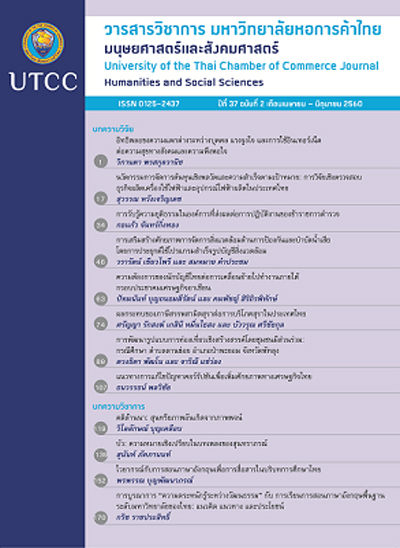Internationalization of Renminbi: International Politics of Becoming a ‘Top Currency’
Main Article Content
Abstract
This article analyses the internationalization process of Renminbi under Susan Strange‘s
‘Politics of International Currencies’ framework and Benjamin Cohen’s and Hyoung-kyu Chey’s
conceptualizations of international monetary. According to the frameworks, China can utilize
key elements under the frameworks to support Renminbi to become a Top Currency. These
include making Renminbi part of other countries’ Foreign Reserves, improving China’s status in
international structure, and using ‘soft power’, providing supports to Asia and Africa countries
through economic aids and trades. Eventually, with these strategies policymakers from various
countries hold positive attitude toward Renminbi and support its wide use internationally. This
should certainly improve Chinese currency status in the international financial system.
Article Details
ลิขสิทธิ์ของบทความ
ผลงานที่ได้รับการตีพิมพ์ถือเป็นลิขสิทธิ์ของมหาวิทยาลัยหอการค้าไทย ห้ามมิให้นำเนื้อหา ทัศนะ หรือข้อคิดเห็นใด ๆ ของผลงานไปทำซ้ำ ดัดแปลง หรือเผยแพร่ ไม่ว่าทั้งหมดหรือบางส่วนโดยไม่ได้รับอนุญาตเป็นลายลักษณ์อักษรจากมหาวิทยาลัยหอการค้าไทยก่อน
References
https://www.irinnews.org/report/98771/analysis-untangling-china-s-aid-to-africa
Bergsten, F. (2009, April 9) We should listen to Beijing’s currency idea. Financial Times. Retrieved from https://www.ft.com/content/7372bbd0-2470-11de-9a01-00144feabdc0
Central Bank of Nigeria Press Release. (2011, September 5). Nigeria approves inclusion of Chinese Renminbi in External Reserves. Retrieved from https://investadvocate.com.ng/2011/09/06/nigeria-approves-inclusion-of-chinese-
renminbi-in-external-reserves/
Chey, H. (2012). Theories of international currencies and the future of the world monetary order. International Studies Review, 14(1), 51-77.
Chey, H. (2013). Can the Renminbi rise as a global currency? The political economy of currency. Asian Survey, 53(2), 348-368.
China to promote Yuan in Africa trade and investment. (2012). Retrieved September 10, 2016, from https://www.bloomberg.com/news/2012-07-14/china-to-promote-yuan-in- africa-trade-andinvestment-daily-says.html
China’s defense budget. (n.d.). Retrieved September 3, 2016, from https://www.globalsecurity.org/military/world/china/budget.htm
Cohen, B. J. (2004). The future of money. Princeton, N.J.: Princeton University Press.
Cohen, B. J. (2013). Currency and state power. In M. Finnemore & J. Goldstein (Eds.) Back to Basics: State Power in a Contemporary World (pp.159-176). Oxford, English: Oxford University Press.
Cohen, B. J. (2014). The Yuan’s Long March. In B. J. Cohen & E. M.P. Chiu (Eds.), Power in a Changing World Economy: Lessons from East Asia (pp.144-159). New York, NY: Routledge.
Cooper, R. N. (2009, September). Policy Brief 09-21: The future of the Dollar. Retrieved from
https://piie.com/sites/default/files/publications/pb/pb09-21.pdf
Currency Composition of Official Foreign Exchange Reserves (COFER), International Financial Statistics (IFS). (2016). Retrieved November 29, 2017, from https://data.imf.org/?sk=E6A5F467-C14B-4AA8-9F6D-5A09EC4E62A4
Dobson, W., & Masson, P. R. (2009). Will Renminbi become a world currency?. China Economic Review, 20(1), 124-135.
Drezner, D. W. (2009). Bad debts: Assessing China’s financial influence in Great Power Politics. International Security, 34(2), 7-45.
Eichengreen, B. (2011). The Renminbi as an international currency. Journal of Policy Modeling, 33(5), 723-730.
Gao, H., & Yu, Y. (2012). Internationalisation of the Renminbi. In Currency Internationalisation: Lessons from the Global Financial Crisis and prospects for the future in Asia and the Pacific, BIS paper No.61, pp 105–124.
Grimes, W. (2003). Internationalization of the Yen and the new politics of monetary insulation. In J. Kirshner (Ed.), Monetary orders: Ambiguous economics, ubiquitous politics (pp.172-194). New York, NY: Cornell University Press.
IMF adds Chinese Renminbi to special drawing rights basket. (2016). Retrieved December 2, 2016, from https://www.imf.org/en/News/Articles/2016/09/29/AM16-NA093016IMF-Adds-Chinese-Renminbi-to-Special-Drawing-Rights-Basket
Ito, T. (2011). The internationalization of the RMB: Opportunities and pitfalls. New York, NY: Council on Foreign Relations.
Krugman, P. (2009, April 2). China’s Dollar Trap. The New York Times. Retrieved from
https://www.nytimes.com/2009/04/03/opinion/03krugman.html
Lee, J. (2014). Will the Renminbi emerge as an international reserve currency?. The World Economy, 37(1), 1-21.
McCaulley, R. N. (2011). Internationalizing the Renminbi and China’s financial development model. New York, NY: Council on Foreign Relations.
McNally, C. A. (2012). Sino-Capitalism: China’s reemergence and the international political economy. World Politics, 64(4), 741-776.
Muhammad, C. (2012). China's Yuan Internationalization: Made in Africa, not Hong Kong. Retrieved September 10, 2016, from https://www.forbes.com/sites/cedricmuhammad/2012/10/16/ chinas-yuan-internationalization-made-in-africa-not-hong-kong/
Nakagawa, T. (2004). Internationalization of the Renminbi (Yuan) and its impact on East Asia. Tokyo, Japan: Institute for International Policy Studies.
Nye, J. S. (Autumn, 1990). Soft Power. Foreign Policy, (80), 153-171.
Park, Y. (2010). RMB Internationalization and its implications for financial and monetary cooperation in East Asia. China & World Economy, 18(2), 1-21.
Pew Research Center. (2013). America’s global image remains more positive than China’s: Chapter 3. Attitudes toward China. Retrieved September 15, 2016, from https://www.pewglobal.org/2013/07/18/chapter-3-attitudes-toward-china/
Strange, S. (1970). International Money Matters. International Affairs, 46(4), 737-743.
Strange, S. (1971a). The politics of international currencies. World Politics, 23(2), 215-231.
Strange, S. (1971b). Stering and British policy: A political view. International Affairs, 47(2), 302-315.
Subacchi, P., & Huang ,H. (2012). The connecting dots of China’s Renminbi strategy: London and Hong Kong. Retrieved November 26, 2016, from https://www.chathamhouse.org/sites/files/chathamhouse/public/Research/International%20Economics/0912bp_subacchi_huang.
Tung, C., Wang, G., & Yeh, J. (2012). Renminbi internationalization: Progress, prospect and comparison. China & World Economy, 20(5), 63-82.
World Trade Organization. (2015). Statistics Database. Retrieved September 10, 2015, from
https://stat.wto.org/Home/WSDBHome.aspx? Language=E [September 10, 2015]
Wu, F., Pan, R., & Wang, D. (2010). Renminbi’s potential to become a global currency. China & World Economy, 18(1), 63-81.
Zhang, M. (2009). China’s new international financial strategy amid the Global Financial Crisis.China & World Economy, 17(5), 22-35.


